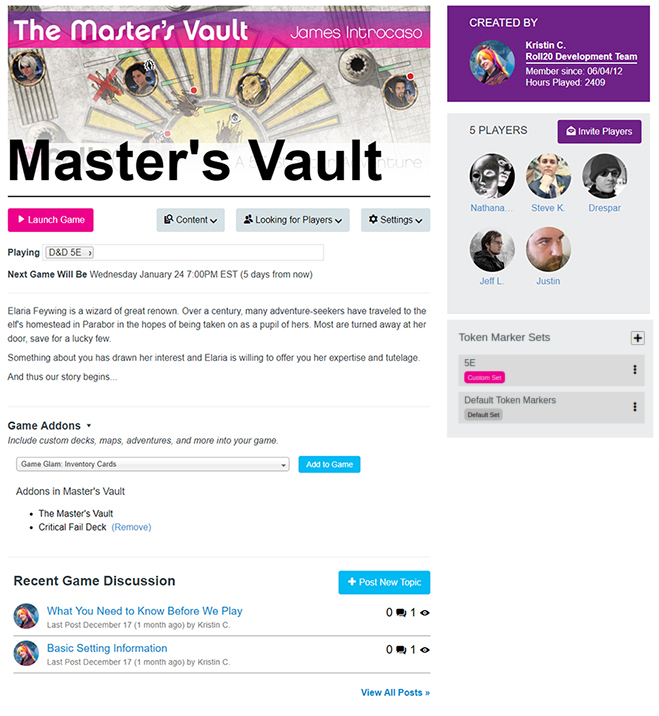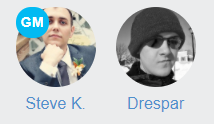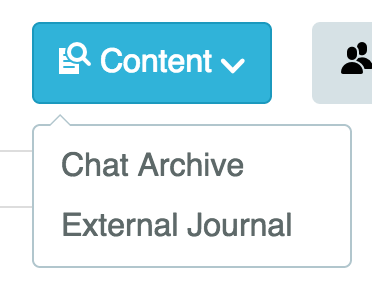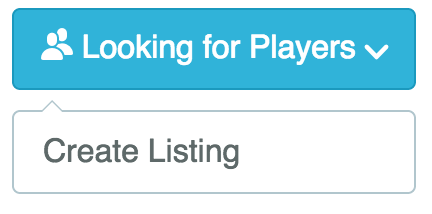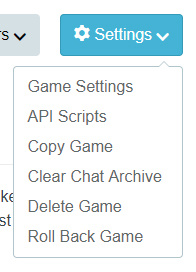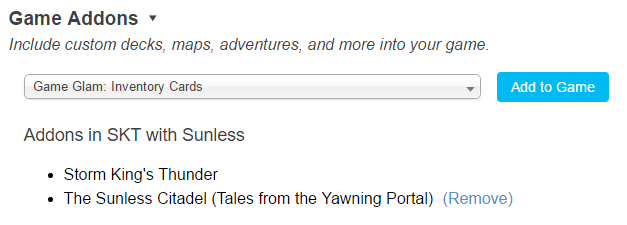Difference between revisions of "Game Management"
From Roll20 Wiki
Andreas J. (Talk | contribs) |
Andreas J. (Talk | contribs) m (→Game Settings) |
||
| Line 85: | Line 85: | ||
====Game Settings==== | ====Game Settings==== | ||
{{main|Game Settings Page}} | {{main|Game Settings Page}} | ||
| + | |||
The [[Game Settings Page]] contains a number of settings such as what [[Character Sheet|character sheet]] is used and it's default settings, as well as {{Compendium}} settings such as [[Compendium Sharing]]. | The [[Game Settings Page]] contains a number of settings such as what [[Character Sheet|character sheet]] is used and it's default settings, as well as {{Compendium}} settings such as [[Compendium Sharing]]. | ||
| + | |||
====API Scripts==== | ====API Scripts==== | ||
This option will give the game’s Creator and GMs access to the [[API:Introduction|API Script Editor]]. The game's Creator must be a Pro subscriber for this feature to be available. | This option will give the game’s Creator and GMs access to the [[API:Introduction|API Script Editor]]. The game's Creator must be a Pro subscriber for this feature to be available. | ||
Revision as of 23:53, 22 November 2020
Attention: Roll20 is no longer maintaining this document on the community wiki. For the most up-to-date information please visit this page on our help center for assistance: Here.
This is a page detailing how to manage and changes settings for individual Games/Campaigns. See the My Games-page for info on all of your games.
Contents
|
Game Details Page
Each game you create in Roll20 has its own dedicated Details Page. This is where player invites can be managed as well as changing any of the game’s settings. Before they hop into the VTT, this is also the first page new players see after accepting an invite to a game. From this page, players can keep track of in-between session content, such as the next game session's date as well as asking questions and starting discussions via the game’s dedicated private forum.
Inviting and Managing Players
On the right hand side of this page is where you can invite and manage the players who will join your game. Within a single game, there are three different roles that a Roll20 user can assume:
Creator
The game’s Creator is the Roll20 user who originally created the game. There is only ever one Creator for a Roll20 game. They have complete control over all of the game's settings and any subscription perks (Dynamic Lighting, F/X Tool, API Scripts, etc…) that the game can benefit from are based on which subscription level the creator’s account currently has. Likewise, content such as Game Add-ons must be bought on the Creator’s account in order for them to be added to the game.
The Creator’s profile image and name are highlighted in purple in the upper right corner of this page. General use stats such as the account creation date and collective hours played are also listed. Clicking on either their name or their profile image will navigate to their Profile Page.
Player
Anyone else who joins the game will be listed as a Player. This section is listed right underneath the Creator in light grey. Players who join the game will be listed in this section with their profile icon followed by their name underneath. They are listed chronologically by when they first joined the game.
GM
The Creator of the game can promote one or more Players in a game to the role of GM. A GM is granted access to alter, add, and delete most of the game's content within Roll20 as well as access a couple of features from the Game Details Page. For this reason, the Creator should practice discretion when promoting Players to this role so these privileges are not abused. A GM, like the Creator, will load into the game on the VTT in GM Mode rather than Player Mode.
A GM has access to the following:
Within the VTT
- Full access to all b Page Layers
- Create, Modify, and Delete Pages
- Place images and tokens to the Tabletop from their personal P Art Library (not the Creator's library)
- Assign and edit tokens
- Create handouts and characters, assign their view and edit permissions
- Move the Player Ribbon to different Pages
- Add, Remove, and Play music from the u Jukebox
- See GM Whispers and Rolls in q Text Chat
- Create Macros and Token Actions
- Modify r Dynamic Lighting on a Page if the game's Creator is a Plus/Pro-subscriber
- Access to all in-game options on the Sidebar's y My Settings Tab in the VTT, except the Transmogrifier
Outside the VTT
- Invite Players (anyone can share the unique join link to the game)
- View and Edit API Scripts (Creator must be a Pro Subscriber)
- Manage the game's private forum, including sinking and deleting posts
A promoted player will have a blue “GM” tag added to the upper left of their profile icon in the Player List.
Inviting, Promoting, and Removing Players From a Game
Inviting Players
At the top of the light grey Players section is an Invite Players button. Clicking on this opens a dialog box that allow you to send invites out via email adresses, view pending invitations, and also list the game’s unique join link URL that you can copy and send to friends so they can join the game directly.
Promoting and Demoting Players
As the game’s creator, you have two options available to you when you hover your mouse over a player’s icon or name:
- ‘’’Promote to GM/Demote to Player’’’: This will elevate a player to GM Status or demote a GM back to player status. This option changes depending on the current status of the player.
Removing a Player From the Game
- ‘’’Kick from Game’’': This will remove the Player from the game and change the unique join link URL of the entire game. This will prevent the Player from attempting to rejoin with the previous join link.
Selecting either of these two options will cause the page to reload to process the new changes.
Managing Your Game
The rest of this page covers information and settings for the game. Most of these options can only be altered by the game’s Creator.
Game Icon
At the top of the Game Details page is the Game Icon, which is an image used to represent your game in the Game List and Looking For Group Listing (if enabled). This image also helps convey the game’s theme to your players when they join it. To set the image, either drag the desired image to this section, or click the Choose a File... button to be prompted to find an image file on your computer. This uploaded image will be added to your P Art Library. Once one is added, you can change the image to something else by hovering your mouse over this area and clicking the Change Image link that appears.
Game Name
The Game Name is used to identify your game in the Game List and Looking For Group Listing (if enabled).You can change the Game Name at any time by clicking the name to edit it. Once you are satisfied with the change, you can click the Save button.
Launch Game
Clicking on the pink Launch Game button will launch the Game on the Roll20 Virtual Tabletop.Content
The Content Button has two menu options available when clicked: Chat Archive and External Journal.
The Chat Archive will open a new window that displays the entire chat history of the game. There is a button in the top right to Hide Whispers in the chat log. Players can only see Whispers and GM rolls of which they were originally a participant.
External Journal Access is available for games with Creators who are paid subscribers. This option redirects to a new page where GMs can view all journal entries for unarchived Characters and Handouts within the game. Players also have access and can view any Characters or Handouts they have control permissions of within the game. Only the "Bio & Info" tab of a character is accessible from the External Journal. An individual's "Character Sheet" or "Attributes and Abilities" tabs can only be accessed within the VTT.
Looking for Players
The Looking for Players menu allows a game's Creator to create or manage a Looking for Group listing. Adding their game to Roll20's game directory will allow other Roll20 users to find and apply to join to it. You must include some basic information about your game in order to list it, including the type of game that you'll be playing and the date and time of the next game to be played.
Settings
The Settings menu provides several options for the game. The game's Creator can access all of these options, while Promoted GMs have limited access. Players only have access to the Leave Game option detailed below.Game Settings
Main Page: Game Settings Page
The Game Settings Page contains a number of settings such as what character sheet is used and it's default settings, as well as i Compendium settings such as Compendium Sharing.
API Scripts
This option will give the game’s Creator and GMs access to the API Script Editor. The game's Creator must be a Pro subscriber for this feature to be available.
Convert Lighting
This is used to convert the Dynamic Lighting settings of pages and tokens from the Legacy Dynamic Lighting to Updated Dynamic Lighting.
Copy Game
This option allows the Creator to create a duplicate of the current game on their account. They can rename the duplicate, change its tags, and decide which elements are carried over to the copy: Players and Player Settings (Including Macros), Pages, Decks and Rollable Tables, Chat Log, N Journal (Characters & Handouts), u Jukebox Playlist, or the Game Forums. Currently, the character sheet will default to None during a copy, so you’ll want to select the sheet you need for the copy. When you have everything designated for the duplicate, click the blue I'm ready, Create Game! button.
Clear Chat Archive
| "Clear Chat Archive" PERMANENTLY deletes the entire archived chat history from everyone. |
This option PERMANENTLY deletes the entire archived chat history from the game.
Sometimes if the chat archive becomes corrupted, the q Text Chat stops working, and it can be solved with Clearing the Chat Archive.
Delete Game
| Deleting game is irreversible for users, and shouldn't be done lightly. If you are lucky, Roll20 developers can recover the game for you. |
This option opens up a dialog box to confirm the Creators’ decision to delete the game.
Roll Back Game
The Creator must have a Pro subscription to have access to this feature. Between the hours of 4 and 6 AM PST, a save state is made for every game on Roll20. Seven days’ worth of save states are kept on file before they’re rewritten with new save states. Pro users have the ability to roll back their game to any save state available from the past seven days to correct any drastic mistakes made to their game.
To commit a rollback, click Roll Back Game. This brings up a dialog box that allows you to choose the date of the save state you would like to roll your game back to. Select the date and click on the pink Rollback button to initiate the rollback process. This may take a minute or two, but once finished, the Game Details Page will prompt you when the rollback has successfully completed. This process cannot be undone; however, you can choose to roll back again to a later save state you have available if you discover you’ve rolled back too far.
Leave Game
This option is only visible to Players and GMs invited to the game. Once a player leaves a game, they no longer have access to the game and it will no longer show up on their Games Page.
Game Information
The next section below the Launch Game and Settings buttons shows specific information about the current game, from what system will be played to when it will be played.
Playing
This field shows what system(s) the Creator has specified are being played in this game. The Creator can edit the Playing list by clicking into the text field and choosing popular systems from the drop-down that appears.
If you don't see your preferred system listed, choose Other Games. This list of available popular games are updated on a quarterly basis and if a game system surges in popularity, it gets added.
Only the first two systems alphabetically will be shown in a Looking For Group listing, so be sure to only choose two if you'll be using that system to find players.
Next Game Will Be
This field is where the game Creator can set the date and time for the game’s next session. The time is automatically converted to the viewer's local timezone.
Note: The time selector uses a 12-hour clock rather than a 24-hour clock. 12:00 AM is used to indicate Midnight (00:00) while 12:00 PM is used to indicate Noon. If you want a 24h clock option, it's recommended to vote & post in this suggestion on the Roll20 Forums.
Game Description
This is where a Game's Creator can add a blurb advertising what to expect out of the game, adventure flavor text, or provide pre-requisites for potential players. This free-form text field is for anything the Creator feels would be convenient for the Players to know.
To edit the description, simply click inside the text field to activate it and change the text to suit your needs. You can use Markdown formatting to customize the look of your description text. When you are satisfied with your changes, click the Save Changes button.
Game Addons
Game Addons, unlike Marketplace modules, are smaller content packages that are meant to enhance your existing games such as: custom card decks, maps, single encounter adventures and more. Once bought, these content packages are available via a dropdown menu in the Game Addons section of the Game Details Page. Select the one you wish to add and click on the blue Add to Game button beside the drop-down menu. When a Game Addon is appended to the game, it will be added to a bulleted list underneath the "Addon in [Title of Current Game]" list. This list is shown underneath the addon drop down menu and the blue Add to Game button.| Adding an Addon more than once will overwrite the previous version of that addon you currently have added to your game. You will lose any changes you may have made, but this will also assists a GM who made any edits by mistake and wish to revert back to the original copy of the Addon. |
Removing Addons
To remove any Game Addon content you've added to a game, you will need to delete it manually from inside the launched game. If you ever delete a Game Addon unintentionally, remove the Addon from the Addon List on the Game Details Page, then add it back in again.
Token Marker Sets
Main Page: Token Markers
You can add custom Token Marker Sets that fits to your games. These sets must have been create in the Token Marker Library beforehand to be accessible to add to individual games.
Game Patching
Occasionally, corrections need to be made to an existing module or game addon. A patch is made to correct the issues discovered. A notification will appear on the Game Details page when a patch is available for a module or addon installed on your game. Typically, a link will be included in the notification to the patch notes that lists all the changes that will be made by the patch.
To preserve as much of your edited content as possible, patches only overwrite the tabletop elements that were directly changed by the patch. It's worthwhile to check the patch notes before updating your game in the off chance you need to duplicate some journal entries to preserve player or GM edited module/addon content. Additionally, if a patch is making changes to a Page you and your players are currently active on, you may want to wait to update your game until after the group is between dungeons/maps. That way elements such as tokens, DL, etc aren't reset mid-combat between gaming sessions.
When you click on the Update button, your game will be sent into a queue to begin the update process. You can cancel the update while it's still sitting in queue and hasn't started processing. You will receive new notifications on the Details Page as a patch moves through the queue line to eventually begin processing the patch. This process can take a couple minutes to complete. Once done, you will receive a final notification that the patch has installed successfully.
Game Discussion Forum
Each game has an exclusive mini forum. It behaves exactly like the public Roll20 forums. Everyone in the game can create their own threads on this forum and also make replies. The game's Creator and GMs all have access to the Sink, Sticky, and Delete commands on individual posts within this forum.
The Sink command will keep a thread at the bottom of the forum regardless of activity.
The Sticky Command will pin the thread to the top of the forum.
The Delete command will remove the post's text from view by those who are not the Creator or GMs. Deleting the first post in a thread will remove the entire thread from the Game Discussion Forum.
This section of the Game Details Page only shows the ten most recent posts from the Game Discussion Forum. To see the entire discussion forum, click on the ‘’’View All Posts >’’’ link at the bottom of the Page.
Clicking on the + Post New Topic button redirect you to full Game Discussion Forum so that you can begin drafting a new forum thread.
See Also
- Game Settings The Settings that manages things related to Character Sheets & i Compendium in individual games
- Roll20 Interface (inside the game)
- My Games Page
- Add Character Sheet to your Game





